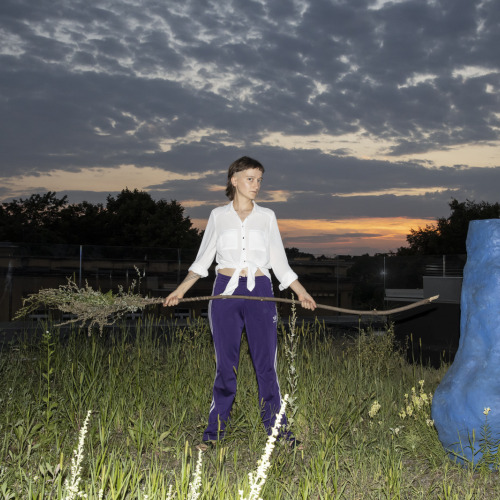
Girl’s Ride (Dívcí jízda)
- Dívci
jízda [Girls’ Ride] is an international photo exhibition.
- It features twelve female artists from six different European countries: the
Czech Republic, Switzerland, Sweden, Slovenia, Bosnia and Herzegovina, and
Turkey.
- Each of these artists is in the process of discovering and re-questioning
identity and their own self-image.
- Society, which demands a perfect female object, conditions an obsessive and
self-centred control of the exterior image and, therefore, its constant
mirroring.
- Each of these artists is pursuing her own solution, seeking it in the
communication of abstract concepts with the help of the visual: truth and
illusion, authenticity and reproduction, memory and historical fact, as well as
that aspect of society which forms everyday life.
- The exhibition attempts to bring new tendencies in contemporary photography
in part of Central Europe into communication with the world.
- The selection of the work in Dívci jízda wasn’t intended as an exposition or
manifestation of the exhibition’s concept, but rather as a dialog in artistic
currents.
- The selection of artists brings together new names alongside well-known names
from the contemporary art scene (V. Bromová, Š. Šimlová, M. Othová, E. Ersen).
Aleksandra Vajd, a graduate of FAMU (Prague) and the curator of the
exhibition, kindly invites you for ‘a ride’.
Vanessa
Punterer
Her series includes thirteen photographs, each titled Portrait. The photographs
were taken in Vilnius, Lithuania. They represent the Lithuanian post-communist
woman in a complex society. In a time of social change, she wants to rise from
anonymity and defend her identity. The scarf covering her hair (its primary
function was to protect against wind and cold) became a sign of independence
and identity. Each of these scarves—and each of their owners—represents a
separate personality conveyed through the violence of the colours, the softness
of the fabric, and the patterns of the floral designs.
Jenny
Rova
Walking on a Line,
her nine-minute video in an infinite loop comes out of a project titled Gender
Geographics at HGKZ in collaboration with Prof. Kaucyila Brooke from CalArts in
Los Angeles. Rova had this to say about her work: ‘The intention of the project
was to find out how gender is related to space and vice versa. I was interested
in how individuals move and occupy their space in public surroundings. While
walking through the city of Zurich, I had the feeling that, as a woman, I had a
tendency to give space to oncoming pedestrians. In an effort to discover the
male-female pattern of walking in public space, I tried to break its rules. I
chose a line that went along the floor at the central train station. I walked
up the line, in my normal walking speed, without stepping out of the way for
anyone. I had myself filmed by a friend following three or four metres behind
me. The camera was hidden in a baby carriage. It was essential to have the
camera well-hidden, because as fast as the pedestrians saw the camera they
behaved differently and stepped out of my way. I wanted to upset their normal
pattern of behaviour. The reactions to my way of walking were very strong. Men
were more aggressive in the morning, while women were more aggressive in the
afternoon. Men were often physically aggressive and would push me out of their
way; sometimes they even hit me. The women would become upset when I did not
apologise, and then they would call me a slut or a hooker– often making sexual
references. My experiment turned out to be a research into the hidden hierarchy
of gender, class and race.’
http://polibilder.hgkz.ch/files/JRova.html
Michaela
Brachtlová
Her work Untitled
hints at latent erotic symbols in confrontation with human body fragments.
Untitled was initially created as a series of illustrations for the book Story
of the Eye, by Georges Bataille, and only later became what it is today.
Untitled presents a confrontation between the human being (and human skin) and
different objects (animal skins, animals, flowers); in this way, it speaks to
Freud and the surrealists. Punterer’s approach to photography is classical; she
uses a large-format camera that gives the photographs perfect sharpness and a
perfect quality of picture and tones.
Dita
Pepe
Her Selfportrait /
Women series began taking shape in 2001. Dita directs herself
and the space she is visiting and takes on the role of ethnographer and
actress. The authenticity of the environment and the persons photographed
remain intact, for Dita never disturbs their concentration, since she views her
models as equal partners. In this way, the subject remains authentic in the
given environment rather than assuming various roles in front of the camera.
Dita’s work presents an infinite game involving all the possible journeys of an
individual—journeys that Dita takes momentarily while still preserving the
anonymity of her story. ‘I feel that everything in life is relative,’ she says.
‘When I look back on my life, if things had been just slightly different, I
could have ended up being someone completely different from who I am now.’
Who Dita is at the end of the road is something we never find out.
http://www.hrubes.com/
Veronika
Drahotová
Her fourteen digital photographs, titled either Veron or Farewell My Concubine,
are one of the two series in her project Mind the Heart. Tomaš Pospiszyl wrote the
following words for the catalogue of her exhibition at the Behomot Gallery in
Prague:
‘Normal life. This phrase does not make any sense and on top of that it carries
the connotation of boredom and fatigue. She still has so much energy that it is
hard to come up with a way of exhausting it, to finally fall asleep at night.
However, the restlessness is always present. She probably should have left a
long time ago, it would have been so easy. Anything but a normal life.
‘There is no point in pretending that the camera is not here. She can see
herself in the reflection of the lens and so she clearly dominates the machine.
She watches the camera and at the same time she watches herself. If she points
the viewfinder in her own direction, then she can even look at how the camera
sees her. Anyway, the best thing would be if she could take her eye out of her
eye socket and point it at herself. That would finally form a mirror with no
delay.’
http://www.veronikadrahotova.com/
Marketa
Othová
Her approach to photography is a naive one, for she never studied photography.
She photographs what she sees independently and unburdened by the rules and
tendencies of contemporary photography. She doesn’t change the reality and doesn’t
manipulate images. She composes her own emotional sentences from the
photographs and sets them in the space of a gallery in precise order. Her
photographs are strictly black and white and usually enlarged to monumental
sizes. The exhibition as a whole functions as an object, and that is probably
also why Marketa documents all her exhibitions. Photographs of photographs are
mostly what is left behind. With her installation Photographic Sentences
she plays roguishly and emotionally in relationship to the viewer.
http://www.the-artists.org/ArtistView.cfm?id=239B62F7-C5CF-11D4-A93800D0B7069B40
Esra
Ersen
Esra’s project came to life during her stays abroad and exists in two versions.
The original version (2000) is called Western Europe or Springtime. It is
composed of four colour photographs (200 cm x137 cm) that also form the basis
for a 2001 series titled Private Eye or Divine Comedy, composed of seven black and
white photocopies. The artist remarks: ‘Receiving several scholarships and
living for a period of time abroad gave me the chance of having short love
affairs during the time. Four photos from my private album (shots during my
stay in Munster) are taken by my ex-boyfriend. Through international
exhibitions, in which I was to show my works, there were always exotic
expectations, like for those in which my foreign boyfriends were also
concerned. In those photos there are no definite clues about which part of the
world they were shot. The chosen environment is a wheat field and it does not
reveal a definite identifying sign. The anonymity continues with the postures:
Is she a cover girl, a warrior, a seductress or a mythological figure?’
http://www.kunstaspekte.de/index.php?k=2184&action=webpages
Šejla
Kameric-Sijercic
She works in the fields of graphic design, photography,
fashion, video, and film.
http://www.sejlakameric.com/
Zvonka
Simcic and Tanja Vujinovic
In her essay ‘Visceral and Metaphysical’ Marina Gržinic writes: ‘Abstract: The
photographs originate from performances the authors made in order to shoot the
videos. The actions are about stylised and inventive research of surrealistic
world. It’s about a combination of hallucinations communicated to us by certain
parts of our bodies, subjected to all kinds of ambiguous voyeuristic uses. Some
of the sequences of the performance show sexual and political fragments
projected onto a naked side of a woman. Faces from the world of the Catholic
church, whose members have recently been accused of child molesting, can also
be seen. These criminal and obscene acts, never ‘really’ condemned by the
church, are projected onto one of the performers in the video-film. The images
are in this way transformed into grotesque posters of evil, pinned to a woman's
side which has taken the function of a cinema screen. The movements of the
lower part of the body additionally contract and deform the faces of
‘perverted’ priests. Exposing a repressive institution like the Catholic church
in this way, Simcic and Vujinovic are opening a powerful chapter in the era of
nudity/disclosure and criticism. Performances based on erotic, surrealistic
tradition and bodily functions could be the antidote to the (frequently) banal
contents developed for and within the boundaries of the new interactive media.’
http://www.i-i-i-i.org/
Veronika
Bromová
Bromová presents her work on a monumental scale. In this way, her photographs
act as provocative concentrates of gentleness, sensibility, absurd pornography,
over-the-top voyeurism and naive curiosity. Her work is based on exploiting the
boundaries of photography as a persuasive medium used for a speculative game
between authenticity and imagination, reality and fiction, intensive silence
and surprisingly loud poetics (ZEMZOO, Room on the Edge of the Horizon, Views,
Beings, Places on Earth). Her work Dua, which is having its premiere, presents
self-portraits of the artist and selected people who were by her side at a
given moment. The work is simply about documenting the artist and the person
next to her. She is interested in the way she changes, depending on whoever is
beside her. The picture is cropped so there is no visible background, because
the portraits were shot in a certain situation and in a certain mood with the
focus on the facial expressions. Numerous portraits form one giant portrait of
Veronika and the people around her, interacting. The photographs were made with
a small hand-held pocket camera.
http://www.artfacts.net/index.php/pageType/artistInfo/artist/14099
Stepánka
Simlová
Already as a student, she started using photography as a reference for further
transformations. Later she recycled all different kinds of photographic images
(amateur snapshots taken from the web, her own photographs) and formed an
orderly composition out of the individual elements. The photograph no longer
gravitates toward the authenticity of the
moment, but rather toward distorting the perspective between the intimate
experience and shared public experience. Re-using general cut-outs of shared
visual experiences, and shifting their meaning in relation to human individual
and society, turns her work into a serious and diverse commentary. Aesthetics
and the use of the media to express oneself constantly follow the ideological
process in keeping up with contemporary artistic trends. The combination of
photographs, installation, fragments of typography, and advertisements makes
her
work accessible to a social understanding.
In cooperation with: Mednarodni grafični likovni center
With the support of: Cultural Link Program (OSI-Budapest), SCCA-LJUBLJANA Zavod
za sodobni umetnost / Center for Contemporary Arts


